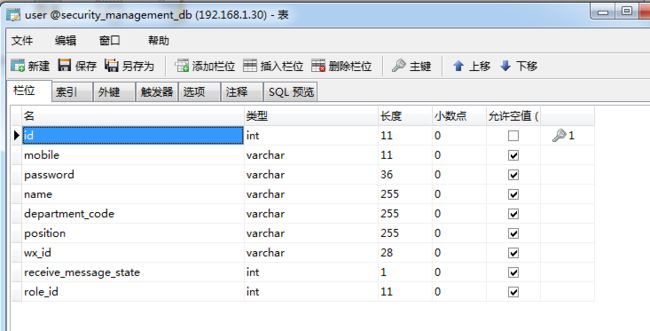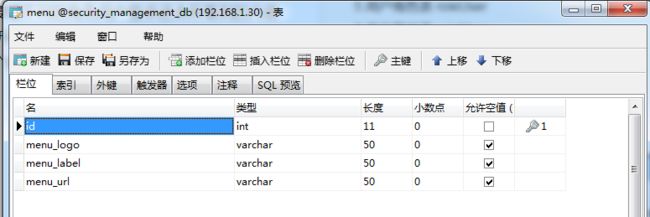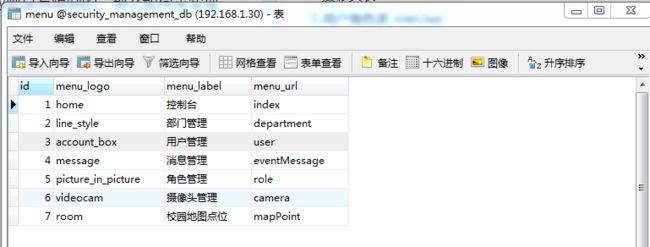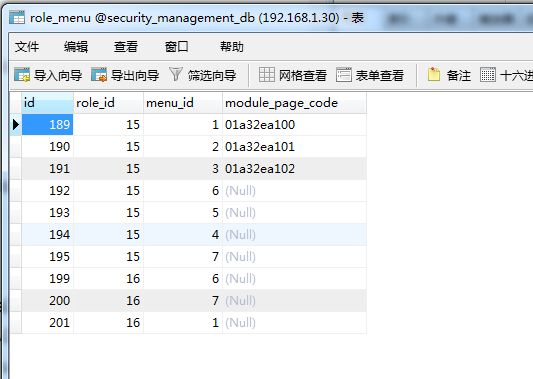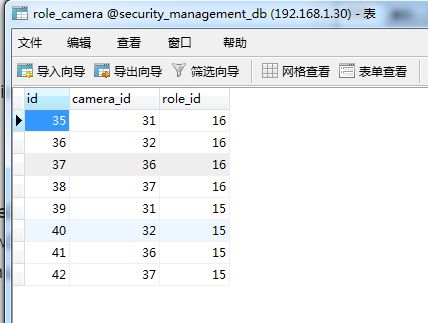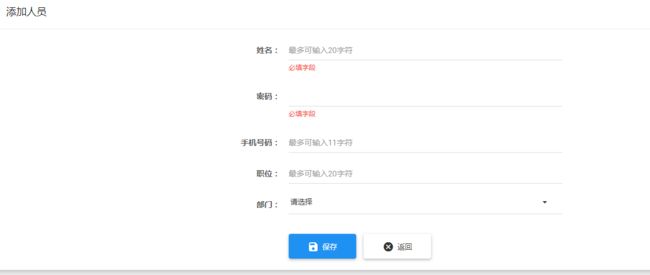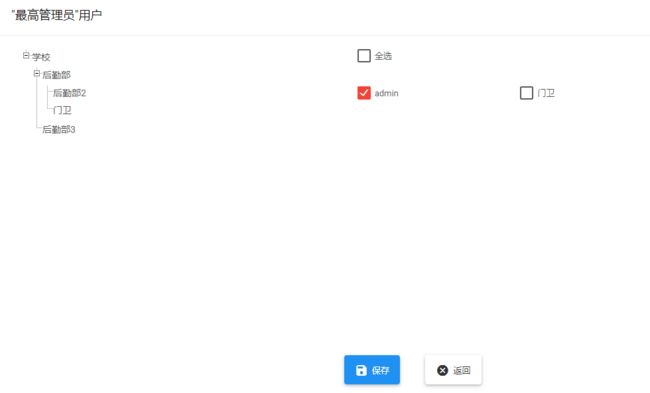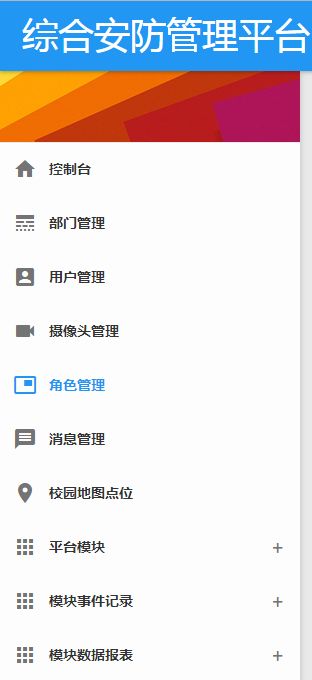假设我们要做一个学校的管理系统,要求不同的角色用户登录进去所看到的内容是不同的,例如校长和门卫登录进去所看到的菜单页面是不同的。校长可以看到全校的摄像头,而门卫看到的摄像头个数则是有限制的。那么如何来实现呢?
首先来分析需要些什么:
1.用户表 user
2.角色表 role
3.菜单表 menu
4.摄像头表 camera
5.用户角色表 roleUser
6.用户菜单表 roleMenu
7.用户摄像头表 roleCamera
以下截图仅供举例参考
关于表的数据就是这些了,里面的字段根据自己的项目需求添加。
前台的整个执行流程是什么呢?
点击保存之后
form表单提交到后台将数据添加到用户表(user)中,这个基本的增删改查不多说了,很简单。
然后写一个角色管理页面,可以配置角色。
点击 添加角色
点击保存,将数据存入role(角色表)基础的增删改查不多说
点击分配用户
之前添加的两个用户展现出来,如果选择用户点击保存,则后台将用户的userId和这个角色的roleId保存到roleUser表中
同理,分配菜单和摄像头都是这个流程。
那么,如果菜单分配好了,假设,我给“最高管理者”这个角色分配了四个菜单,“次管理者”这个角色分配了两个菜单,将用户“校长”分配给“最高管理者”这个角色。也就是说,校长这个用户登录进入这个平台的时候应该只能看见四个菜单。
新建一个控制器:platformController
package com.lencity.securitymanagementplatform.controller;
import java.util.ArrayList;
import java.util.List;
import javax.servlet.http.HttpSession;
import org.springframework.beans.factory.annotation.Autowired;
import org.springframework.context.annotation.Scope;
import org.springframework.stereotype.Controller;
import org.springframework.web.bind.annotation.GetMapping;
import org.springframework.web.bind.annotation.PathVariable;
import org.springframework.web.bind.annotation.PostMapping;
import org.springframework.web.bind.annotation.RequestMapping;
import org.springframework.web.bind.annotation.ResponseBody;
import org.springframework.web.servlet.ModelAndView;
import com.alibaba.fastjson.JSONObject;
import com.lencity.securitymanagementplatform.data.entity.Camera;
import com.lencity.securitymanagementplatform.data.entity.Menu;
import com.lencity.securitymanagementplatform.data.entity.Role;
import com.lencity.securitymanagementplatform.data.entity.RoleMenu;
import com.lencity.securitymanagementplatform.data.entity.RoleUser;
import com.lencity.securitymanagementplatform.data.entity.User;
import com.lencity.securitymanagementplatform.data.service.MenuService;
import com.lencity.securitymanagementplatform.data.service.RoleMenuService;
import com.lencity.securitymanagementplatform.data.service.RoleUserService;
import com.lencity.securitymanagementplatform.data.service.UserService;
@Controller
@Scope("session")
@RequestMapping("")
public class PlatformController {
@Autowired
private UserService userService;
@Autowired
private RoleUserService roleUserService;
@Autowired
private RoleMenuService roleMenuService;
@Autowired
private MenuService menuService;
@GetMapping("/")
public String index() {
return "forward:/login.html";
}
@PostMapping(value = "/login", produces = "application/json;charset=utf-8")
@ResponseBody
public String login(String name, String password, HttpSession session) {
User user = userService.login(name, password);
if (user == null) {
session.removeAttribute("loginUser");
return "0";
}
session.setAttribute("loginUser", user);
return "1";
}
@RequestMapping(value = "/logout", produces = "application/json;charset=utf-8")
@ResponseBody
public String logout(HttpSession session) {
session.removeAttribute("user");
return "1";
}
@RequestMapping(value = "/changePassword", produces = "application/json;charset=utf-8")
@ResponseBody
public String changePassword(String oldPassword, String newPassword, HttpSession session) {
User user = (User) session.getAttribute("user");
boolean result = userService.changePassword(user.getName(), oldPassword, newPassword);
return result ? "1" : "0";
}
}
JS
function login() {
$("#form").ajaxSubmit({
type : 'POST',
cache : false,
success : function(result) {
if (result == "0") {
alert("帐号或密码错误,请重新输入!");
} else {
location.href = "user";
}
}
});
}
接下来就是拦截器
package com.lencity.securitymanagementplatform.interceptor;
import java.io.IOException;
import java.util.ArrayList;
import java.util.List;
import javax.servlet.http.HttpServletRequest;
import javax.servlet.http.HttpServletResponse;
import javax.servlet.http.HttpSession;
import org.springframework.beans.factory.annotation.Autowired;
import org.springframework.stereotype.Component;
import org.springframework.web.servlet.HandlerInterceptor;
import com.lencity.securitymanagementplatform.data.entity.Menu;
import com.lencity.securitymanagementplatform.data.entity.RoleMenu;
import com.lencity.securitymanagementplatform.data.entity.RoleUser;
import com.lencity.securitymanagementplatform.data.entity.User;
import com.lencity.securitymanagementplatform.data.service.MenuService;
import com.lencity.securitymanagementplatform.data.service.ModuleService;
import com.lencity.securitymanagementplatform.data.service.RoleMenuService;
import com.lencity.securitymanagementplatform.data.service.RoleUserService;
@Component
public class PlatformInterceptor implements HandlerInterceptor {
@Autowired
private ModuleService moduleService;
@Autowired
private RoleMenuService roleMenuService;
@Autowired
private RoleUserService roleUserService;
@Autowired
private MenuService menuService;
@Override
public boolean preHandle(HttpServletRequest request, HttpServletResponse response, Object handler)
throws Exception {
HttpSession session = request.getSession();
if (session.getAttribute("moduleMenus") == null) {
session.setAttribute("moduleMenus", moduleService.getModuleMenus());
}
User user = (User) session.getAttribute("loginUser");
if (user != null) {
RoleUser roleUser = roleUserService.getUserByUserId(user.getId());
List roleMenus = roleMenuService.getRoleMenuByRoleId(roleUser.getRoleId());
List package com.lencity.securitymanagementplatform;
import java.util.ArrayList;
import java.util.List;
import org.springframework.beans.factory.annotation.Autowired;
import org.springframework.context.annotation.Configuration;
import org.springframework.web.servlet.config.annotation.InterceptorRegistry;
import org.springframework.web.servlet.config.annotation.WebMvcConfigurer;
import com.lencity.securitymanagementplatform.interceptor.ModuleInterceptor;
import com.lencity.securitymanagementplatform.interceptor.PlatformInterceptor;
@Configuration
public class PlatformWebConfiguration implements WebMvcConfigurer {
@Autowired
private PlatformInterceptor platformInterceptor;
@Autowired
private ModuleInterceptor moduleInterceptor;
@Override
public void addInterceptors(InterceptorRegistry registry) {
List platformExcludePathes = new ArrayList<>();
platformExcludePathes.add("/moduleInterface/**");
platformExcludePathes.add("/");
platformExcludePathes.add("/platform/**");
platformExcludePathes.add("/login.html");
platformExcludePathes.add("/login");
platformExcludePathes.add("/publicData/**");
platformExcludePathes.add("/library/**");
platformExcludePathes.add("/data/**");
platformExcludePathes.add("/image/**");
platformExcludePathes.add("/js/**");
platformExcludePathes.add("/*.txt");
registry.addInterceptor(platformInterceptor).addPathPatterns("/**").excludePathPatterns(platformExcludePathes);
registry.addInterceptor(moduleInterceptor).addPathPatterns("/moduleInterface/**");
WebMvcConfigurer.super.addInterceptors(registry);
}
}
通过拦截器,userId去查询roleId,然后通过roleId去查询roleMenu 的菜单id
,最后通过菜单id去查询菜单表。存入session中。
menu.html
循环遍历session中的menus,展现如下效果
Over~
